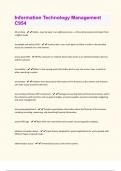Samenvatting
Biopsychology and Neuropsychology - Summary for the Exam -IBP -Leiden University - 6461PS010
- Vak
- Instelling
- Boek
Complete and detailed course summary for "Biopsychology and Neuropsychology" course at Leiden University, IBP. I got a 9.0 on this exam by studying from this summary! The summary includes: - All chapters required for the course (visible in the table of contents) - Lecture material integrat...
[Meer zien]












